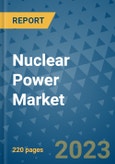1. Executive Summary
1.1. Global Nuclear Power Market Snapshot
1.2. Key Market Trends
1.3. Future Projections
1.4. Analyst Recommendations
2. Market Overview
2.1. Market Definitions and Segmentations
2.2. Market Dynamics
2.2.1. Drivers
2.2.1.1. Driver A
2.2.1.2. Driver B
2.2.1.3. Driver C
2.2.2. Restraints
2.2.2.1. Restraint 1
2.2.2.2. Restraint 2
2.2.3. Market Opportunities Matrix
2.3. Value Chain Analysis
2.4. Porter’s Five Forces Analysis
2.5. Covid-19 Impact Analysis
2.5.1. Pre-Covid and Post-Covid Scenario
2.5.2. Supply Impact
2.5.3. Demand Impact
2.6. Government Regulations
2.7. Global Energy Mix, 2022 - Overview
2.8. Technology Landscape
2.9. Economic Analysis
2.10. PESTLE
3. Installed Capacity, 2018 - 2022
3.1. Regional Production Statistics
3.1.1. North America
3.1.2. Europe
3.1.3. Asia Pacific
3.1.4. Latin America
3.1.5. Middle East & Africa
3.2. New Installations, 2023 - 2030, by Region
4. Price Trends Analysis and Future Projects, 2018 - 2030
4.1. Key Highlights
4.2. Prominent Factors Affecting Prices
4.3. By Region
5. Global Nuclear Power Market Outlook, 2018 - 2030
5.1. Global Nuclear Power Market Outlook, by Reactor Type, Installed Capacity (GW(e)), 2018 - 2030
5.1.1. Key Highlights
5.1.1.1. Pressurized Water Reactor (PWR)
5.1.1.2. Boiling Water Reactor (BWR)
5.1.1.3. Pressurized Heavy-water Reactor (PHWR)
5.1.1.4. Light Water Graphite Reactor (LWGR)
5.1.1.5. Misc. (GCR, FNR, HTGR, etc.)
5.2. Global Nuclear Power Market Outlook, by Application, Installed Capacity (GW(e)), 2018 - 2030
5.2.1. Key Highlights
5.2.1.1. Electricity
5.2.1.2. Space & Defence
5.2.1.3. Misc.
5.2.2. BPS/Market Attractiveness Analysis
5.3. Global Nuclear Power Market Outlook, by Region, Installed Capacity (GW(e)), 2018 - 2030
5.3.1. Key Highlights
5.3.1.1. North America
5.3.1.2. Europe
5.3.1.3. Asia Pacific
5.3.1.4. Latin America
5.3.1.5. Middle East & Africa
5.3.2. BPS/Market Attractiveness Analysis
6. North America Nuclear Power Market Outlook, 2018 - 2030
6.1. North America Nuclear Power Market Outlook, by Reactor Type, Installed Capacity (GW(e)), 2018 - 2030
6.1.1. Key Highlights
6.1.1.1. Pressurized Water Reactor (PWR)
6.1.1.2. Boiling Water Reactor (BWR)
6.1.1.3. Pressurized Heavy-water Reactor (PHWR)
6.1.1.4. Light Water Graphite Reactor (LWGR)
6.1.1.5. Misc. (GCR, FNR, HTGR, etc.)
6.2. North America Nuclear Power Market Outlook, by Application, Installed Capacity (GW(e)), 2018 - 2030
6.2.1. Key Highlights
6.2.1.1. Electricity
6.2.1.2. Space & Defence
6.2.1.3. Misc.
6.3. North America Nuclear Power Market Outlook, by Country, Installed Capacity (GW(e)), 2018 - 2030
6.3.1. Key Highlights
6.3.1.1. U.S.
6.3.1.2. Canada
6.3.2. BPS/Market Attractiveness Analysis
7. Europe Nuclear Power Market Outlook, 2018 - 2030
7.1. Europe Nuclear Power Market Outlook, by Reactor Type, Installed Capacity (GW(e)), 2018 - 2030
7.1.1. Key Highlights
7.1.1.1. Pressurized Water Reactor (PWR)
7.1.1.2. Boiling Water Reactor (BWR)
7.1.1.3. Pressurized Heavy-water Reactor (PHWR)
7.1.1.4. Light Water Graphite Reactor (LWGR)
7.1.1.5. Misc. (GCR, FNR, HTGR, etc.)
7.2. Europe Nuclear Power Market Outlook, by Application, Installed Capacity (GW(e)), 2018 - 2030
7.2.1. Key Highlights
7.2.1.1. Electricity
7.2.1.2. Space & Defence
7.2.1.3. Misc.
7.3. Europe Nuclear Power Market Outlook, by Country, Installed Capacity (GW(e)), 2018 - 2030
7.3.1. Key Highlights
7.3.1.1. Germany
7.3.1.2. France
7.3.1.3. U.K.
7.3.1.4. Italy
7.3.1.5. Spain
7.3.1.6. Russia
7.3.1.7. Rest of Europe
7.3.2. BPS/Market Attractiveness Analysis
8. Asia Pacific Nuclear Power Market Outlook, 2018 - 2030
8.1. Asia Pacific Nuclear Power Market Outlook, by Reactor Type, Installed Capacity (GW(e)), 2018-2030
8.1.1. Key Highlights
8.1.1.1. Pressurized Water Reactor (PWR)
8.1.1.2. Boiling Water Reactor (BWR)
8.1.1.3. Pressurized Heavy-water Reactor (PHWR)
8.1.1.4. Light Water Graphite Reactor (LWGR)
8.1.1.5. Misc. (GCR, FNR, HTGR, etc.)
8.2. Asia Pacific Nuclear Power Market Outlook, by Application, Installed Capacity (GW(e)), 2018 - 2030
8.2.1. Key Highlights
8.2.1.1. Electricity
8.2.1.2. Space & Defence
8.2.1.3. Misc.
8.3. Asia Pacific Nuclear Power Market Outlook, by Country, Installed Capacity (GW(e)), 2018 - 2030
8.3.1. Key Highlights
8.3.1.1. China
8.3.1.2. Japan
8.3.1.3. South Korea
8.3.1.4. India
8.3.1.5. Southeast Asia
8.3.1.6. Rest of Asia Pacific
8.3.2. BPS/Market Attractiveness Analysis
9. Latin America Nuclear Power Market Outlook, 2018 - 2030
9.1. Latin America Nuclear Power Market Outlook, by Reactor Type, Installed Capacity (GW(e)), 2018 - 2030
9.1.1. Key Highlights
9.1.1.1. Pressurized Water Reactor (PWR)
9.1.1.2. Boiling Water Reactor (BWR)
9.1.1.3. Pressurized Heavy-water Reactor (PHWR)
9.1.1.4. Light Water Graphite Reactor (LWGR)
9.1.1.5. Misc. (GCR, FNR, HTGR, etc.)
9.2. Latin America Nuclear Power Market Outlook, by Application, Installed Capacity (GW(e)), 2018-2030
9.2.1. Key Highlights
9.2.1.1. Electricity
9.2.1.2. Space & Defence
9.2.1.3. Misc.
9.3. Latin America Nuclear Power Market Outlook, by Country, Installed Capacity (GW(e)), 2018 - 2030
9.3.1. Key Highlights
9.3.1.1. Brazil
9.3.1.2. Mexico
9.3.1.3. Rest of Latin America
9.3.2. BPS/Market Attractiveness Analysis
10. Middle East & Africa Nuclear Power Market Outlook, 2018 - 2030
10.1. Middle East & Africa Nuclear Power Market Outlook, by Reactor Type, Installed Capacity (GW(e)), 2018 - 2030
10.1.1. Key Highlights
10.1.1.1. Pressurized Water Reactor (PWR)
10.1.1.2. Boiling Water Reactor (BWR)
10.1.1.3. Pressurized Heavy-water Reactor (PHWR)
10.1.1.4. Light Water Graphite Reactor (LWGR)
10.1.1.5. Misc. (GCR, FNR, HTGR, etc.)
10.2. Middle East & Africa Nuclear Power Market Outlook, by Application, Installed Capacity (GW(e)), 2018 - 2030
10.2.1. Key Highlights
10.2.1.1. Electricity
10.2.1.2. Space & Defence
10.2.1.3. Misc.
10.3. Middle East & Africa Nuclear Power Market Outlook, by Country, Installed Capacity (GW(e)), 2018 - 2030
10.3.1. Key Highlights
10.3.1.1. GCC
10.3.1.2. South Africa
10.3.1.3. Rest of Middle East & Africa
10.3.2. BPS/Market Attractiveness Analysis
11. Competitive Landscape
11.1. Company Market Share Analysis, 2021
11.2. Competitive Dashboard
11.3. Company Profiles
11.3.1. China General Nuclear Power Group
11.3.1.1. Company Overview
11.3.1.2. Product Portfolio
11.3.1.3. Financial Overview
11.3.1.4. Business Strategies and Development
11.3.2. Électricité de France S.A
11.3.3. The China National Nuclear Corporation
11.3.4. Constellation Energy Corporation
11.3.5. Rosatom State Nuclear Energy Corporation
11.3.6. Areva
11.3.7. Korea Electric Power Corp
11.3.8. Ontario Power Generation Inc.
11.3.9. Centrus Energy Corp.
11.3.10. NNEGC Energoatom
11.3.11. The Iberdrola Group
12. Appendix
12.1. Research Methodology
12.2. Report Assumptions
12.3. Acronyms and Abbreviations








